Self-Consolidated Concrete-to-Conductive Concrete Interface: Assessment of Bond Strength and Mechanical Properties
Abstract
:1. Introduction and Background
1.1. Surface Preparation and Cleanness
1.2. Differential Shrinkage, Stiffness, and Age
1.3. Fibers and Other Materials Present in the Mix
1.4. Common Bond Strength Tests
2. Research Significance
3. Experimental Investigation
3.1. Concrete Mixes and Mixing Sequence
3.2. Sample Preparation
3.3. Test Setups and Instrumentation
3.3.1. Compressive, MOE, and Split Tension Tests
3.3.2. Flexural Tests
3.3.3. Slant Shear Tests
3.3.4. Direct Shear Tests
4. Results
4.1. Mechanical Properties of CC and SCC
4.2. Concrete-to-Concrete Bond Strength in Compression Test
4.3. Concrete-to-Concrete Bond Strength in Modulus of Elasticity Test
4.4. Concrete-to-Concrete Bond Strength in Flexure Strength Test
4.5. Concrete-to-Concrete Bond Strength in Slant Shear Test
4.6. Failure Modes
4.6.1. Compression and MOE Failure Modes
4.6.2. Flexural Failure Modes
4.6.3. Slant Shear Failure Modes
4.6.4. Split Tension and Direct Shear Failure Modes
5. Discussion
5.1. Data Normalization Due to Compressive Strength Variation
5.2. Control Samples
5.2.1. Compressive and MOE Control Samples
5.2.2. Flexure Control Samples
5.2.3. Slant Control Samples
5.2.4. Split Tension
5.2.5. Direct Shear
5.3. Surface Preparation
5.3.1. Surface Preparation Effect on Compression Strength
5.3.2. Surface Preparation Effects on MOE
5.3.3. Surface Preparation Effects on Flexural Strength
5.3.4. Surface Preparation Effects on Slant Shear
5.4. Casting and Testing Directions
5.4.1. Casting and Testing Direction Effects on Compression Strength
5.4.2. Casting and Testing Direction Effects on MOE
5.4.3. Casting and Testing Direction Effects on Flexure Strength
5.4.4. Casting and Testing Direction Effects on Slant Shear
6. Comparison of CC and SCC Mechanical Properties with Published Equations
7. Conclusions
- The SCC’s compressive strength and stiffness were superior to those of the conductive concrete. The difference in compressive strength was due to the addition of conductive fillers, which replaced parts of the mix. The conductive fillers added to the mix were carbon, graphite, and hybrid steel fibers (HSFs). The compressive strength difference was 19% at 28 days and 13% at 90 days, both in favor of the SCC mix; similarly, the stiffness difference was 35% in favor of the SCC.
- The CC flexural, tensile, and shear strengths were superior to those of the SCC mix. This was due to the presence of HSFs in the mix, which increased the performance. In addition, the HSF allowed the CC mix to be more ductile than the SCC mix, which was observed in the CC samples’ failure modes. The CC’s flexural strength improvement was 4 times that of the SCC’s flexural strength. Similarly, the CC’s tensile and shear strengths were 2 times that of the SCC’s strengths. Moreover, the HSF allowed for better crack growth control and post-peak performance.
- The most suitable surface preparation method to fully utilize the CC mix was the shear key method. The shear key method is based on a groove grid performed initially on a mold, after which the mix is cast into it. However, the rough surface preparation, performed using hand chiseling and a steel wire brush, achieved a similar bond strength to the wet-to-wet surface preparation when the roughness was applied to the SCC’s surface in the slant shear test. However, if the rough surface preparation is applied to the CC mix’s surface, the bond strength would fail. It is important to note that wet-to-wet surface preparation is performed to simulate the maximum bond strength.
- The casting and testing directions played important roles, which could be seen in the flexural strength tests. The most suitable position for conductive concrete is in the tensile region of an element. If the SCC mix is present in the tensile region, it will weaken the sample’s strength and residual capacity. In WNWC, the flexural strength and post-peak performance were similar to those of the CC control. However, in WCWN, the strength dropped significantly, which was due to the SCC’s position. Moreover, the SCC’s presence in the tensile region subjected the sample to a sudden stress due to its initial sudden failure, after which the CC carried the rest of the load.
- An attempt to predict the SCC’s and CC’s mechanical properties based on codes and published equations was made. Most codes and published equations could predict the SCC’s MOE, flexural, and tensile strength. However, care must be taken with CC mixes, since most equations overestimated the MOE and underestimated the tensile and flexural strengths. This issue occurred only due to the presence of conductive fillers, which affected the mechanical properties by either increasing or decreasing performance.
Author Contributions
Funding
Data Availability Statement
Acknowledgments
Conflicts of Interest
Disclaimer
Abbreviations
| CC | Conductive concrete |
| DN | Dry normal |
| DC | Dry conductive |
| HSF | Hybrid steel fiber |
| LVDT | Linear variable displacement transducer |
| M1, M3, M5, M7 | Odd numbers used for CC mixes |
| M2, M4, M6, M8 | Even numbers used for SCC mixes |
| MOE | Modulus of elasticity |
| SCC | Self-consolidated concrete |
| SFs | Steel fibers |
| SG | Strain gauge |
| SK | Shear key |
| UHPC | Ultra-high-performance concrete |
| UTM | Universal testing machine |
| WC | Wet conductive |
| WN | Wet normal |
| WADB | Wet concrete type A on dry concrete type B |
| WAWB | Wet concrete type A on wet concrete type B |
| WCWN | Wet conductive concrete over wet normal concrete |
| WCDN-S | Wet conductive over dry normal with smooth surface |
| WCDN-R | Wet conductive over dry normal with rough surface |
| WNDC-SK | Wet normal over dry conductive with shear key |
| Interface area | |
| Expected shearing area | |
| Average width of specimen | |
| Cylinder diameter | |
| Modulus of elasticity | |
| Flexural strength | |
| Shear strength | |
| Compressive strength | |
| Specimen depth | |
| Maximum load | |
| Tensile strength | |
| Slant shear angle with respect to the y-axis | |
| Longitudinal strain | |
| Transverse strain | |
| Stress | |
| Normal stress | |
| Shear stress | |
| Poisson’s ratio |
References
- Yehia, S.; Qaddoumi, N.; Hassan, M.; Swaked, B. Conductive Concrete for Electromagnetic Shielding Applications. Adv. Civ. Eng. Mater. 2014, 3, 270–290. [Google Scholar] [CrossRef]
- Han, J.; Pan, J.; Cai, J.; Li, X. A review on carbon-based self-sensing cementitious composites. Constr. Build. Mater. 2020, 265, 120764. [Google Scholar] [CrossRef]
- Wang, L.; Aslani, F. A review on material design, performance, and practical application of electrically conductive cementitious composites. Constr. Build. Mater. 2019, 229, 116892. [Google Scholar] [CrossRef]
- Yehia, S.; Tuan, C.Y.; Ferdon, D.; Chen, B. Conductive concrete overlay for bridge deck deicing: Mixture proportioning, optimization, and properties. ACI Struct. J. 2000, 97, 172–181. [Google Scholar]
- Azhari, F.; Banthia, N. Carbon fiber-reinforced cementitious composites for tensile strain sensing. ACI Mater. J. 2017, 114, 129–136. [Google Scholar]
- El-Dieb, A.; El-Ghareeb, M.; Abdel-Rahman, M.; Nasr, E. Multifunctional electrically conductive concrete using different fillers. J. Build. Eng. 2018, 15, 61–69. [Google Scholar] [CrossRef]
- Han, B.; Ding, S.; Yu, X. Intrinsic self-sensing concrete and structures: A review. Meas. J. Int. Meas. Confed. 2015, 59, 110–128. [Google Scholar] [CrossRef]
- Khalid, T.; Albasha, L.; Qaddoumi, N.; Yehia, S. Feasibility Study of Using Electrically Conductive Concrete for Electromagnetic Shielding Applications as a Substitute for Carbon-Laced Polyurethane Absorbers in Anechoic Chambers. IEEE Trans. Antennas Propag. 2017, 65, 2428–2435. [Google Scholar] [CrossRef]
- Swaked, B.; Qaddoumi, N.; Yehia, S.; Farhana, S.; Nguyen, L. Conductive Concrete for Smart Cities Applications. In Proceedings of the 2019 AEIT International Annual Conference (AEIT), Florence, Italy, 18–20 September 2019; pp. 1–5. [Google Scholar]
- Han, B.; Wang, Y.; Dong, S.; Zhang, L.; Ding, S.; Yu, X.; Ou, J. Smart concretes and structures: A review. J. Intell. Mater. Syst. Struct. 2015, 26, 1303–1345. [Google Scholar] [CrossRef]
- Gomis, J.; Galao, O.; Gomis, V.; Zornoza, E.; Garcés, P. Self-heating and deicing conductive cement. Experimental study and modeling. Constr. Build. Mater. 2015, 75, 442–449. [Google Scholar] [CrossRef]
- Wanasinghe, D.; Aslani, F.; Ma, G.; Habibi, D. Advancements in electromagnetic interference shielding cementitious composites. Constr. Build. Mater. 2020, 231, 117116. [Google Scholar] [CrossRef]
- Momayez, A.; Ehsani, M.R.; Ramezanianpour, A.A.; Rajaie, H. Comparison of methods for evaluating bond strength between concrete substrate and repair materials. Cem. Concr. Res. 2005, 35, 748–757. [Google Scholar] [CrossRef]
- Cristina, Z.; Banthia, N.; Giovanni, P. A study of some factors affecting bond in cementitious fiber reinforced repairs. Cem. Concr. Res. 2014, 63, 117–126. [Google Scholar]
- Santos, P.; Julio, E. Factors affecting bond between new and old concrete. ACI Mater. J. 2011, 108, 449–456. [Google Scholar]
- Afandi, M.E.L.; Yehia, S.; Landolsi, T.; Qaddoumi, N.; Elchalakani, M. Concrete-to-concrete bond Strength: A review. Constr. Build. Mater. 2023, 363, 129820. [Google Scholar] [CrossRef]
- Elbakry, H.M.F.; Tarabia, A.M. Factors affecting bond strength of RC column jackets. Alexandria Eng. J. 2016, 55, 57–67. [Google Scholar] [CrossRef]
- Gadri, K.; Guettala, A. Evaluation of bond strength between sand concrete as new repair material and ordinary concrete substrate (The surface roughness effect). Constr. Build. Mater. 2017, 157, 1133–1144. [Google Scholar] [CrossRef]
- Munoz, M.; Harris, D.; Ahlborn, T.; Froster, D. Bond Performance between Ultrahigh-Performance Concrete and Normal-Strength Concrete. Mater. Civ. Eng. 2014, 26, 04014031. [Google Scholar] [CrossRef]
- Zanotti, C.; Randl, N. Are concrete-concrete bond tests comparable? Cem. Concr. Compos. 2019, 99, 80–88. [Google Scholar] [CrossRef]
- Zanotti, C.; Borges, P.H.R.; Bhutta, A.; Banthia, N. Bond strength between concrete substrate and metakaolin geopolymer repair mortar: Effect of curing regime and PVA fiber reinforcement. Cem. Concr. Compos. 2017, 80, 307–316. [Google Scholar] [CrossRef]
- Silfwerbrand, J. Shear bond strength in repaired concrete structures. Mater. Struct. Constr. 2003, 36, 419–424. [Google Scholar] [CrossRef]
- Banthia, N.; Zanotti, C.; Sappakittipakorn, M. Sustainable fiber reinforced concrete for repair applications. Constr. Build. Mater. 2014, 67, 405–412. [Google Scholar] [CrossRef]
- Yazdi, M.A.; Dejager, E.; Debraekeleer, M.; Gruyaert, E.; Van Tittelboom, K.; De Belie, N. Bond strength between concrete and repair mortar and its relation with concrete removal techniques and substrate composition. Constr. Build. Mater. 2020, 230, 116900. [Google Scholar] [CrossRef]
- Feng, S.; Xiao, H.; Li, H. Comparative studies of the effect of ultrahigh-performance concrete and normal concrete as repair materials on interfacial bond properties and microstructure. Eng. Struct. 2020, 222, 111122. [Google Scholar] [CrossRef]
- Courard, L.; Piotrowski, T.; Garbacz, A. Near-to-surface properties affecting bond strength in concrete repair. Cem. Concr. Compos. 2014, 46, 73–80. [Google Scholar] [CrossRef]
- Wang, B.; Li, Q.; Liu, F.; Wang, J.; Xu, S. Shear bond assessment of UHTCC repair using push-out test. Constr. Build. Mater. 2018, 164, 206–216. [Google Scholar] [CrossRef]
- Mirmoghtadaei, R.; Mohammadi, M.; Samani, N.; Mousavi, S. The impact of surface preparation on the bond strength of repaired concrete by metakaolin containing concrete. Constr. Build. Mater. 2015, 80, 76–83. [Google Scholar] [CrossRef]
- Jafarinejad, S.; Rabiee, A.; Shekarchi, M. Experimental investigation on the bond strength between Ultra high strength Fiber Reinforced Cementitious Mortar & conventional concrete. Constr. Build. Mater. 2019, 229, 116814. [Google Scholar]
- Costa, H.; Carmo, R.N.F.; Júlio, E. Influence of lightweight aggregates concrete on the bond strength of concrete-to-concrete interfaces. Constr. Build. Mater. 2018, 180, 519–530. [Google Scholar] [CrossRef]
- Zhang, Y.; Zhu, P.; Liao, Z.; Wang, L. Interfacial bond properties between normal strength concrete substrate and ultra-high-performance concrete as a repair material. Constr. Build. Mater. 2020, 235, 117431. [Google Scholar] [CrossRef]
- Zhang, X.; Zhang, S.; Luo, Y.; Wang, L. Effects of Interface Orientations on Bond Strength between Old Conventional Concrete and New Self-Consolidating Concrete. ACI Struct. J. 2020, 117, 191–201. [Google Scholar]
- Tayeh, B.; Bakar, B.H.A.; Johari, M.A.M. Characterization of the interfacial bond between old concrete substrate and ultra high-performance fiber concrete repair composite. Mater. Struct. 2013, 46, 743–753. [Google Scholar] [CrossRef]
- Tayeh, B.A.; Bakar, B.H.A.; Johari, M.A.M.; Voo, Y.L. Evaluation of bond strength between normal concrete substrate and ultra high-performance fiber concrete as a repair material. Procedia Eng. 2013, 54, 554–563. [Google Scholar] [CrossRef]
- Semendary, A.A.; Svecova, D. Factors affecting bond between precast concrete and cast in place ultra-high performance concrete (UHPC). Eng. Struct. 2020, 216, 110746. [Google Scholar] [CrossRef]
- Diab, A.; Elmoaty, A.E.A.; Eldin, M.T. Slant shear bond strength between self-compacting concrete and old concrete. Constr. Build. Mater. 2017, 130, 73–82. [Google Scholar] [CrossRef]
- Ju, Y.; Shen, T.; Wang, D. Bonding behavior between reactive powder concrete and normal strength concrete. Constr. Build. Mater. 2020, 242, 118024. [Google Scholar] [CrossRef]
- Gao, D.; Chen, X.; Chen, G.; Zhang, L.; Zhan, Z. Shear-bond behaviour between concrete and hybrid fibre-reinforced cementitious composites for repairing: Experimental and modelling. J. Build. Eng. 2023, 64, 105636. [Google Scholar] [CrossRef]
- Skominas, R.; Gurskis, V.; Sadzevicius, R.; Damulevicius, V.; Radzevicius, A. Evaluation of cement mortar suitability for repairing concrete in hydraulic structures. KSCE J. Civ. Eng. 2017, 21, 2814–2820. [Google Scholar] [CrossRef]
- Daneshvar, D.; Behnood, A.; Robisson, A. Interfacial bond in concrete-to-concrete composites: A review. Constr. Build. Mater. 2022, 359, 129195. [Google Scholar] [CrossRef]
- Yehia, S.; Douba, A.E.; Abdullahi, O.; Farrag, S. Mechanical and durability evaluation of fiber-reinforced self-compacting concrete. Constr. Build. Mater. 2016, 121, 120–133. [Google Scholar] [CrossRef]
- ASTM C39/C39M; Standard Test Method for Compressive Strength of Cylindrical Concrete Specimens. ASTM International: West Conshohocken, PA, USA, 2021; pp. 1–8.
- ASTM C469-22; Standard Test Method for Static Modulus of Elasticity and Poisson’s Ratio of Concrete in Compression. ASTM International: West Conshohocken, PA, USA, 2022; Volume 4, pp. 1–5.
- ASTM C496/496M-17; Standard Test Method for Splitting Tensile Strength of Cylindrical Concrete Specimens. ASTM International: West Conshohocken, PA, USA, 2017; pp. 1–5.
- ASTM C1609/C1609M-19; Standard Test Method for Flexural Performance of Fiber-Reinforced Concrete (Using Beam with Third-Point Loading). ASTM International: West Conshohocken, PA, USA, 2019; pp. 1–9.
- ASTM C78-22; Standard Test Method for Flexural Strength of Concrete (Using Simple Beam with Third-Point Loading). ASTM International: West Conshohocken, PA, USA, 2022; pp. 1–3.
- BS EN 12615:1999; Products and Systems for the Protection and Repair of Concrete Structures. The British Standards Institution: London, UK, 1999; Volume 3.
- BS 1881-116:1983; Testing Concrete. British Standards Institution: London, UK, 2003; pp. 1–3.
- Tuan, C.Y.; Yehia, S. Evaluation of electrically conductive concrete containing carbon products for deicing. ACI Mater. J. 2004, 101, 287–293. [Google Scholar]
- Erdem, S.; Hanbay, S.; Blankson, M.A. Self-sensing damage assessment and image-based surface crack quantification of carbon nanofibre reinforced concrete. Constr. Build. Mater. 2017, 134, 520–529. [Google Scholar] [CrossRef]
- Cholker, A.K.; Tantray, M.A. Micro carbon fiber-based concrete as a strain-damage sensing material. Mater. Today Proc. 2019, 19, 152–157. [Google Scholar] [CrossRef]
- Chen, M.; Gao, P.; Geng, F.; Zhang, L.; Liu, H. Mechanical and smart properties of carbon fiber and graphite conductive concrete for internal damage monitoring of structure. Constr. Build. Mater. 2017, 142, 320–327. [Google Scholar] [CrossRef]
- Lee, S.H.; Kim, S.; Yoo, D.Y. Hybrid effects of steel fiber and carbon nanotube on self-sensing capability of ultra-high-performance concrete. Constr. Build. Mater. 2018, 185, 530–544. [Google Scholar] [CrossRef]
- Liu, Y.; Shi, C.; Zhang, Z.; Li, N.; Shi, D. Mechanical and fracture properties of ultra-high performance geopolymer concrete: Effects of steel fiber and silica fume. Cem. Concr. Compos. 2020, 112, 103665. [Google Scholar] [CrossRef]
- Karimipour, A.; Ghalehnovi, M.; de Brito, J. Mechanical and durability properties of steel fibre-reinforced rubberised concrete. Constr. Build. Mater. 2020, 257, 119463. [Google Scholar] [CrossRef]
- Keneth Celestine, A.; Prakash, M.; Satyanarayanan, K.S.; Rajah Surya, T.; Parthasarathi, N. The interpretation of mechanical study of concrete using crimped steel fibres. Mater. Today Proc. 2020, 40, S88–S92. [Google Scholar] [CrossRef]
- Ghoneim, M.; Yehia, A.; Yehia, S.; Abuzaid, W. Shear strength of fiber reinforced recycled aggregate concrete. Materials 2020, 13, 4183. [Google Scholar] [CrossRef]
- Wang, W.; Shen, A.; Lyu, Z.; He, Z.; Nguyen, K. Fresh and rheological characteristics of fiber reinforced concrete—A review. Constr. Build. Mater. 2021, 296, 123734. [Google Scholar] [CrossRef]
- Wani, T.A.; Ganesh, S. Study on fresh properties, mechanical properties and microstructure behavior of fiber reinforced self compacting concrete: A review. Mater. Today Proc. 2022, 62 Pt 12, 6663–6670. [Google Scholar] [CrossRef]
- ACI 318; An ACI Standard Building Code Requirements for Structural Concrete (ACI 318-19) Commentary on Building Code Requirements for Structural Concrete (ACI 318R-19). ACI: Farmington Hills, MI, USA, 2019.
- ACI-363-10; Report on High-Strength Concrete. American Concrete Institute: Farmington Hills, MI, USA, 2010.
- FIB-International. FIB Model Code; FIB: Lausanne, Switzerland, 2010; Volume 1. [Google Scholar]
- ENV 1992-1-1:1992; Eurocode 2: Design of Concrete Structures. British Standards Institution: London, UK, 2015; pp. 1–194.
- Kim, K.-C.; Yang, I.-H.; Joh, C. Effects of Single and Hybrid Steel Fiber Lengths and Fiber Contents on the Mechanical Properties of High-Strength Fiber-Reinforced Concrete. Adv. Civ. Eng. 2018, 2018, 7826156. [Google Scholar] [CrossRef]
- Suksawang, N.; Wtaife, S.; Alsabbagh, A. Evaluation of elastic modulus of fiber-reinforced concrete. ACI Mater. J. 2018, 115, 239–249. [Google Scholar] [CrossRef]
- Thomas, J.; Ramaswamy, A. Mechanical Properties of Steel Fiber-Reinforced Concrete. Mater. Civ. Eng. 2008, 19, 385–392. [Google Scholar] [CrossRef]
- Xu, B.W.; Shi, H.S. Correlations among mechanical properties of steel fiber reinforced concrete. Constr. Build. Mater. 2009, 23, 3468–3474. [Google Scholar] [CrossRef]
- Perumal, R. Correlation of Compressive Strength and Other Engineering Properties of High-Performance Steel Fiber–Reinforced Concrete. Mater. Civ. Eng. 2014, 27, 04014114. [Google Scholar] [CrossRef]
- Rashid, M.A.; Mansur, M.A.; Paramasivam, P. Correlations between Mechanical Properties of High-Strength Concrete. Mater. Civ. Eng. 2002, 14, 230–238. [Google Scholar] [CrossRef]
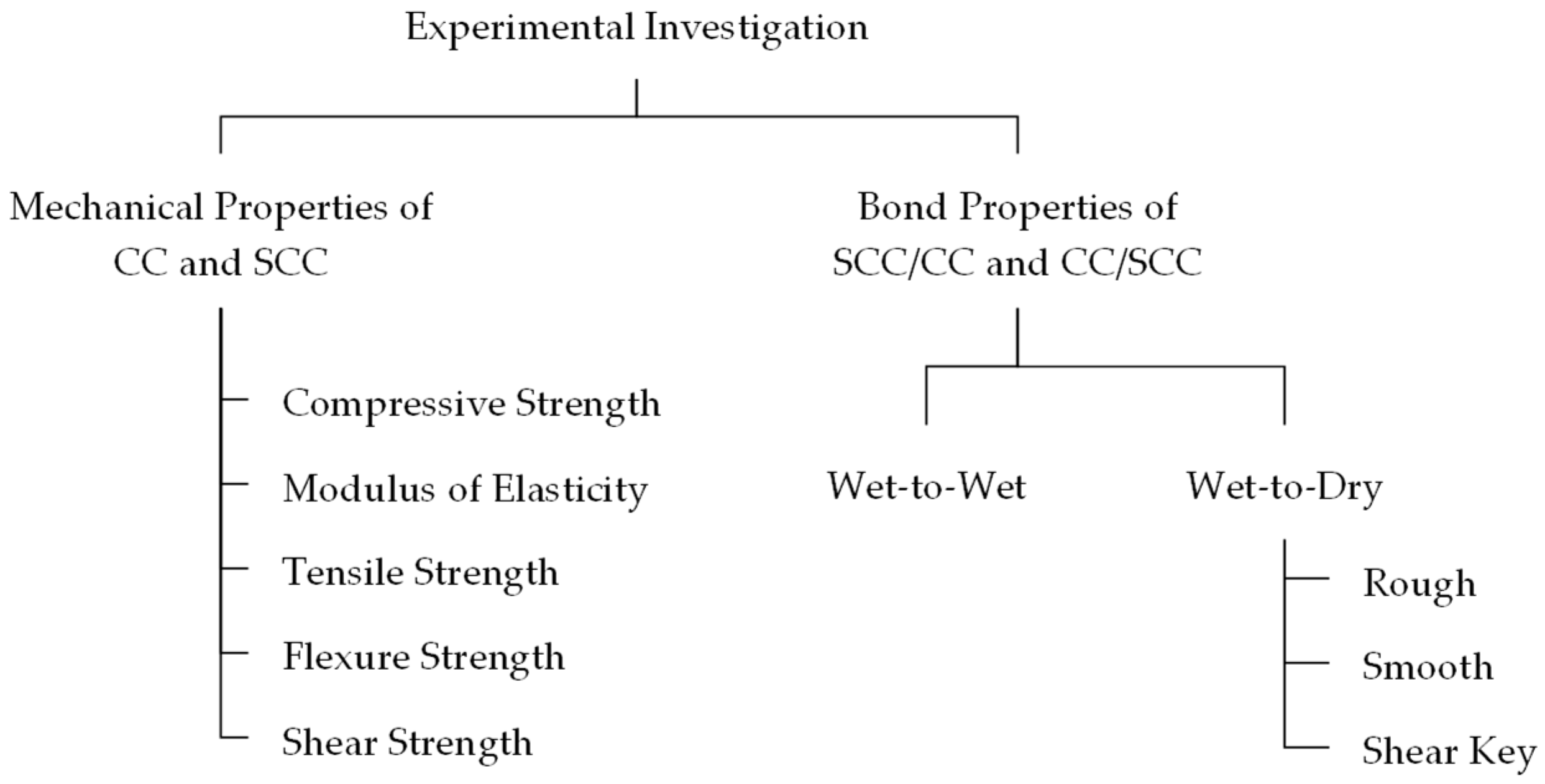
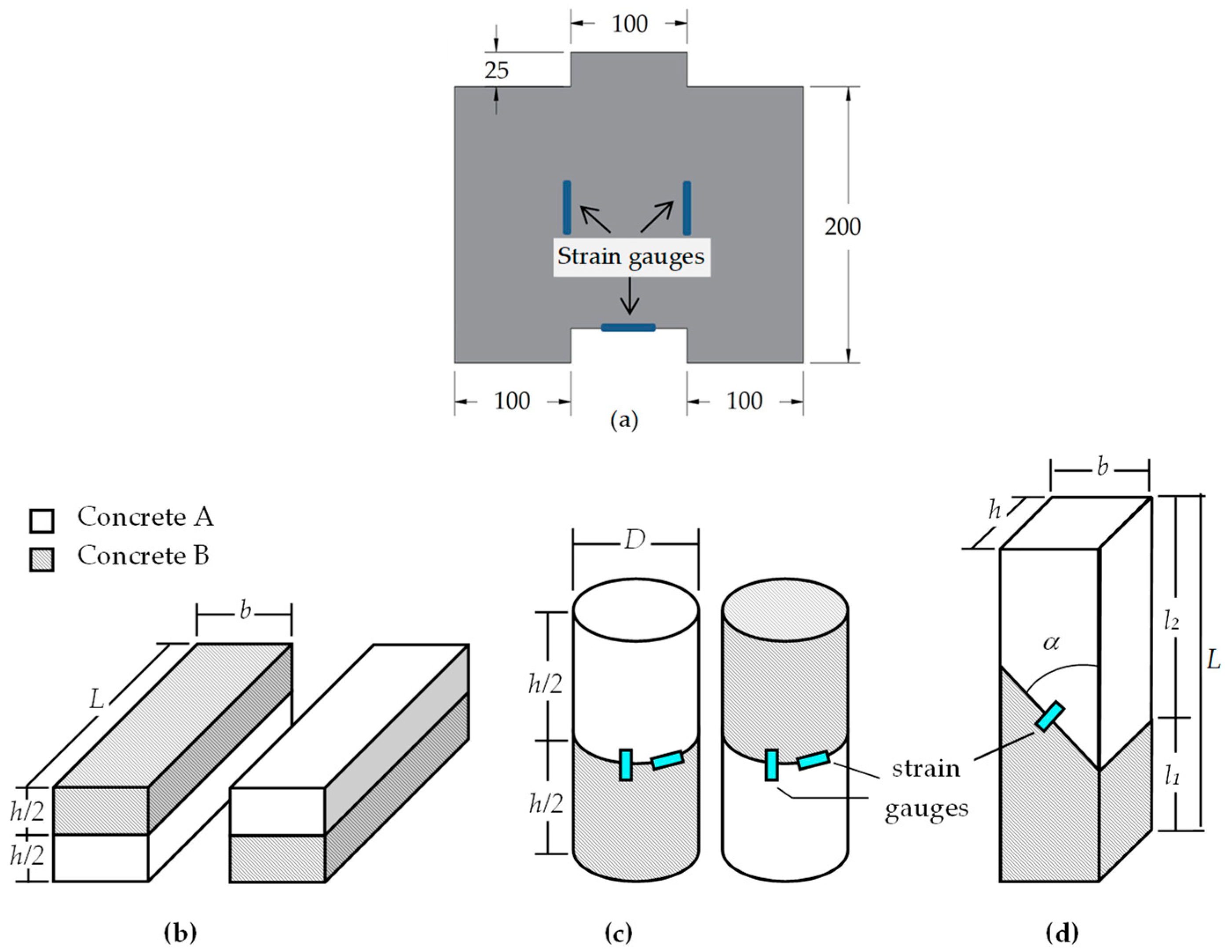

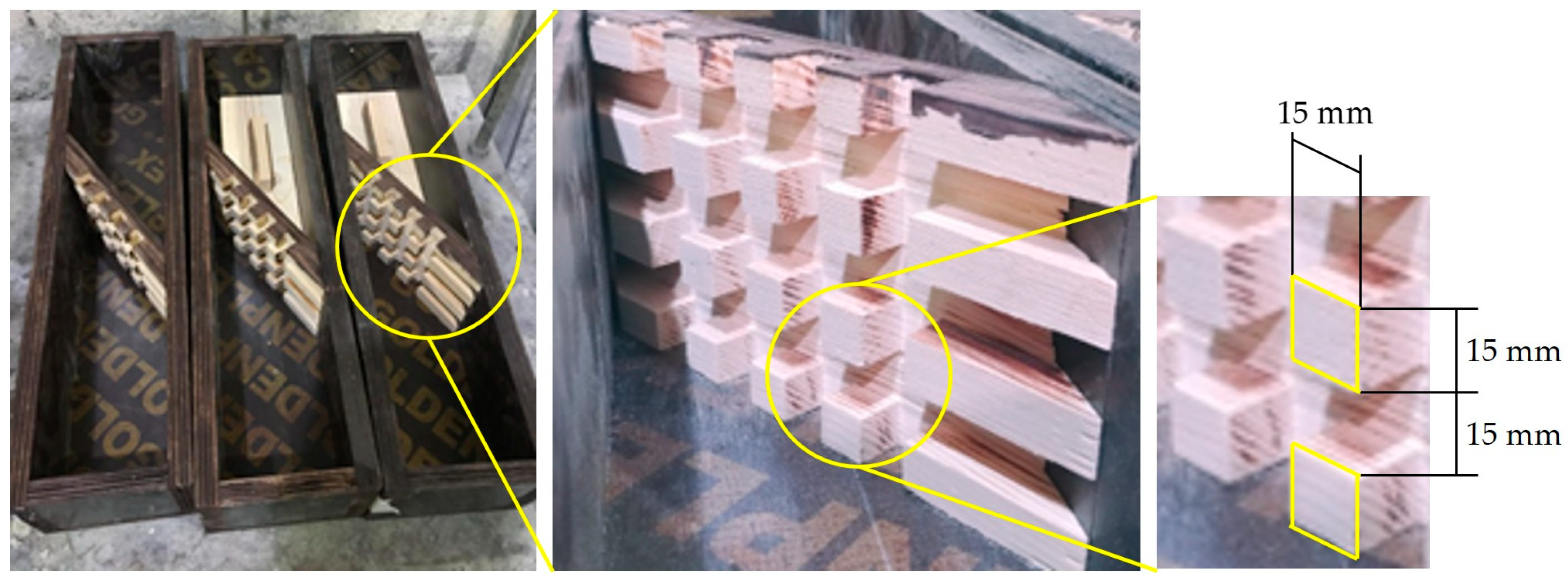
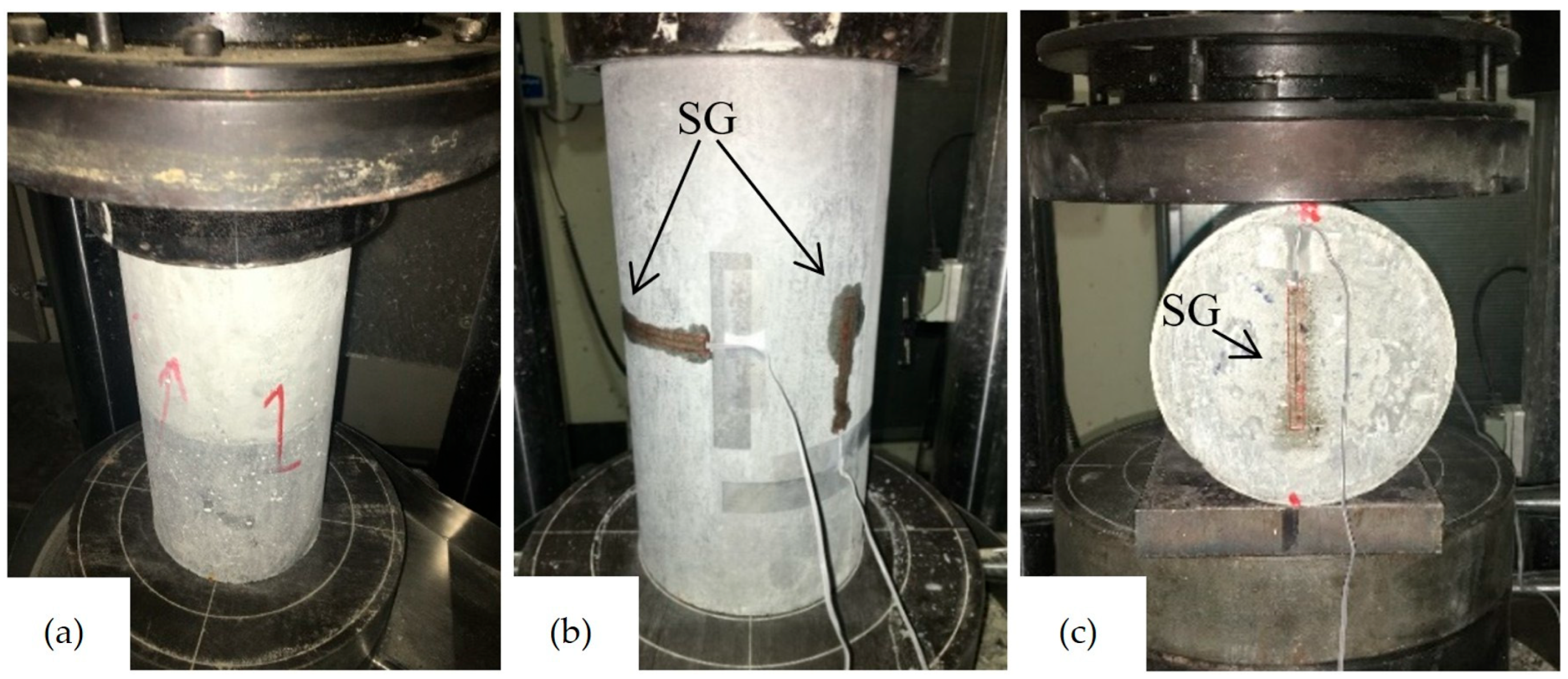
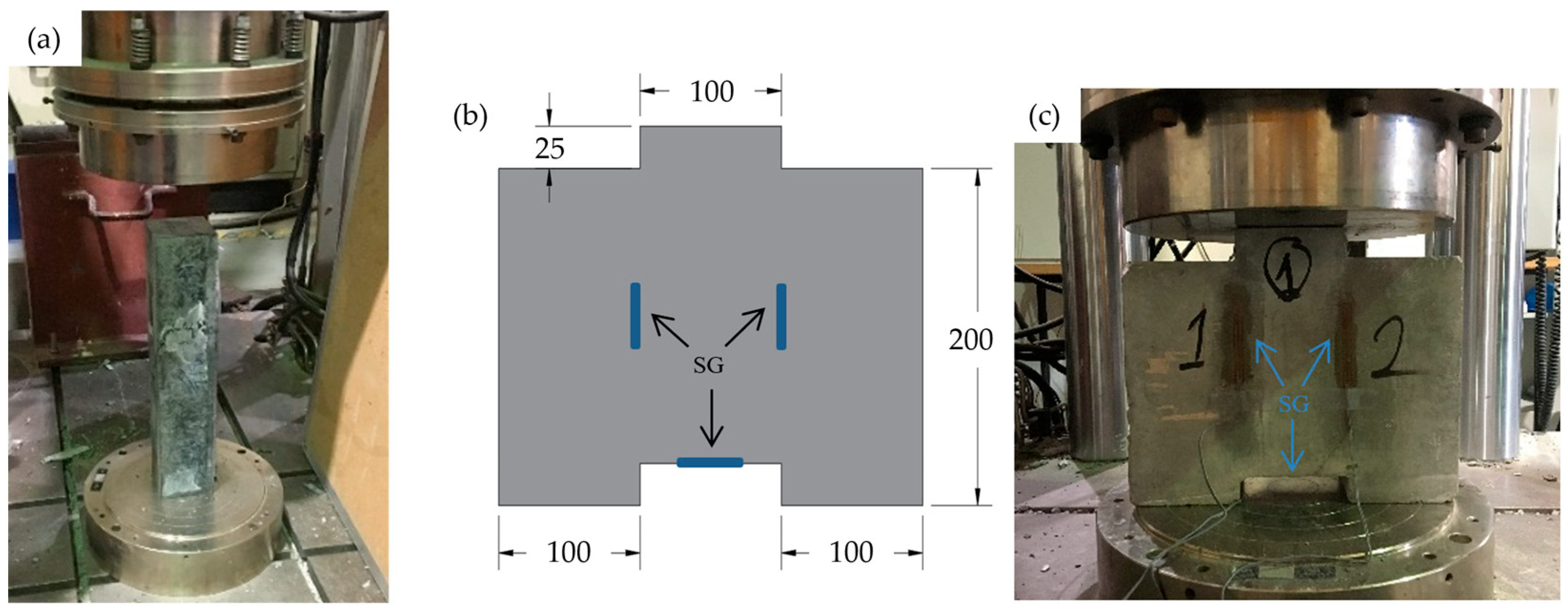
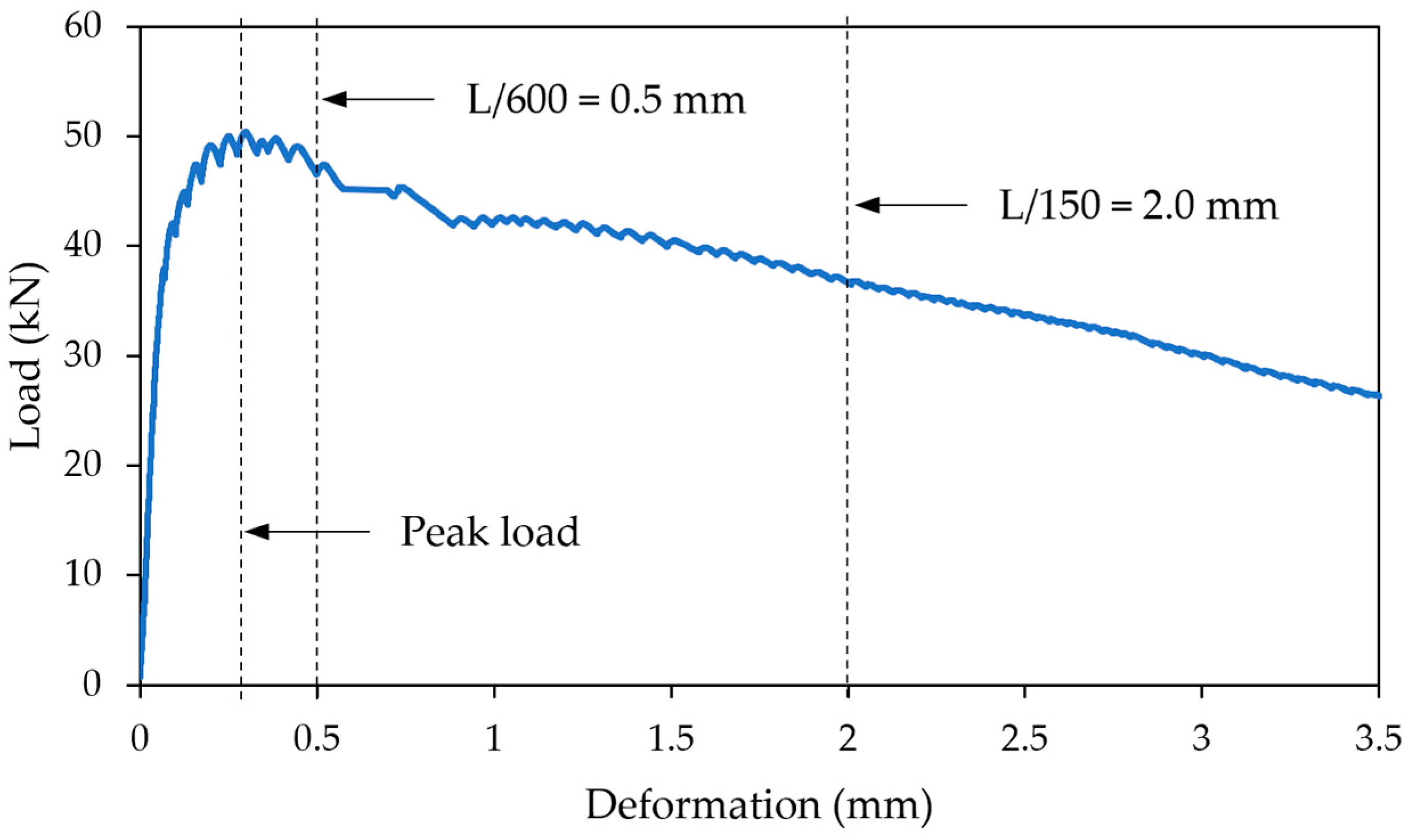

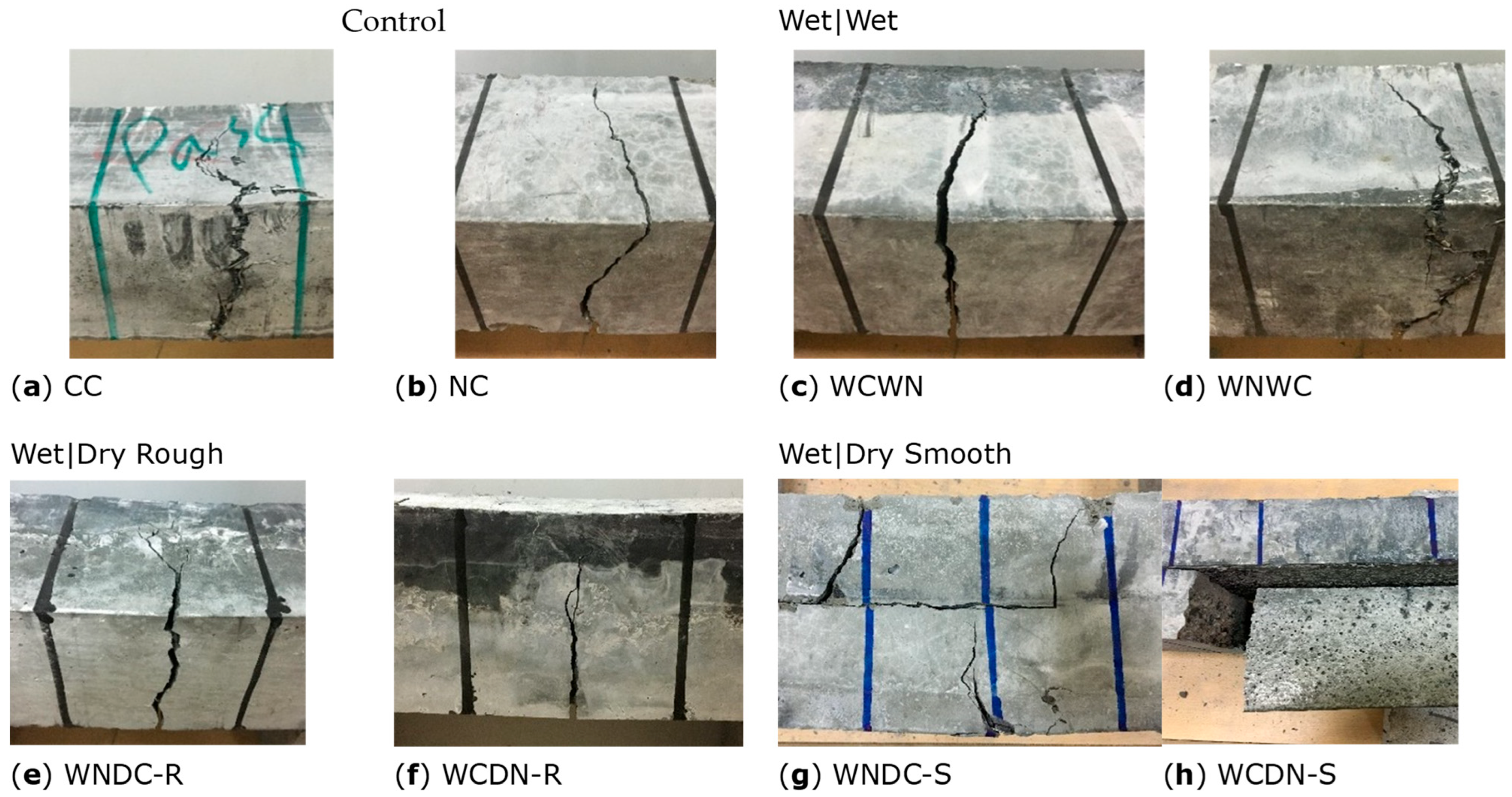
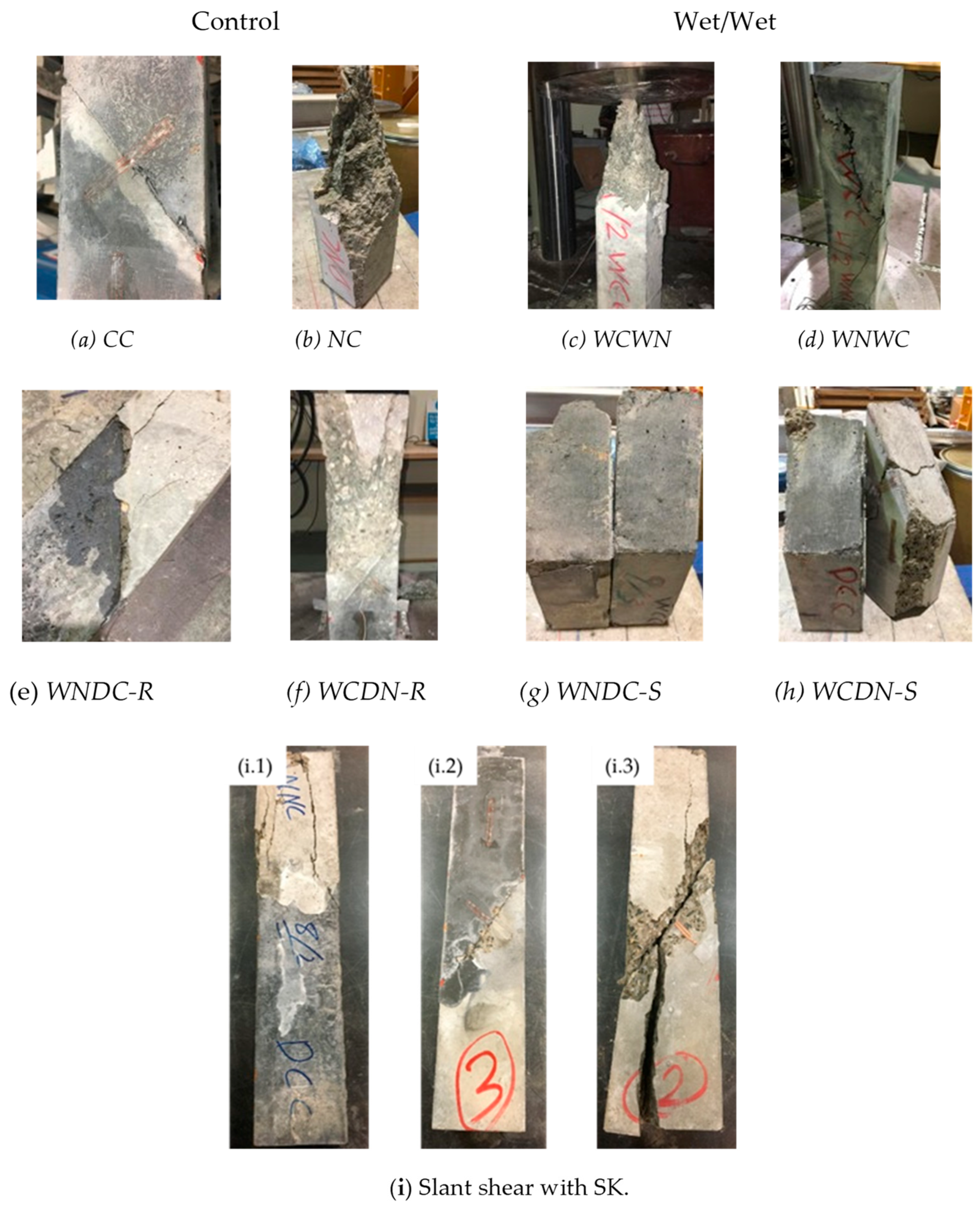
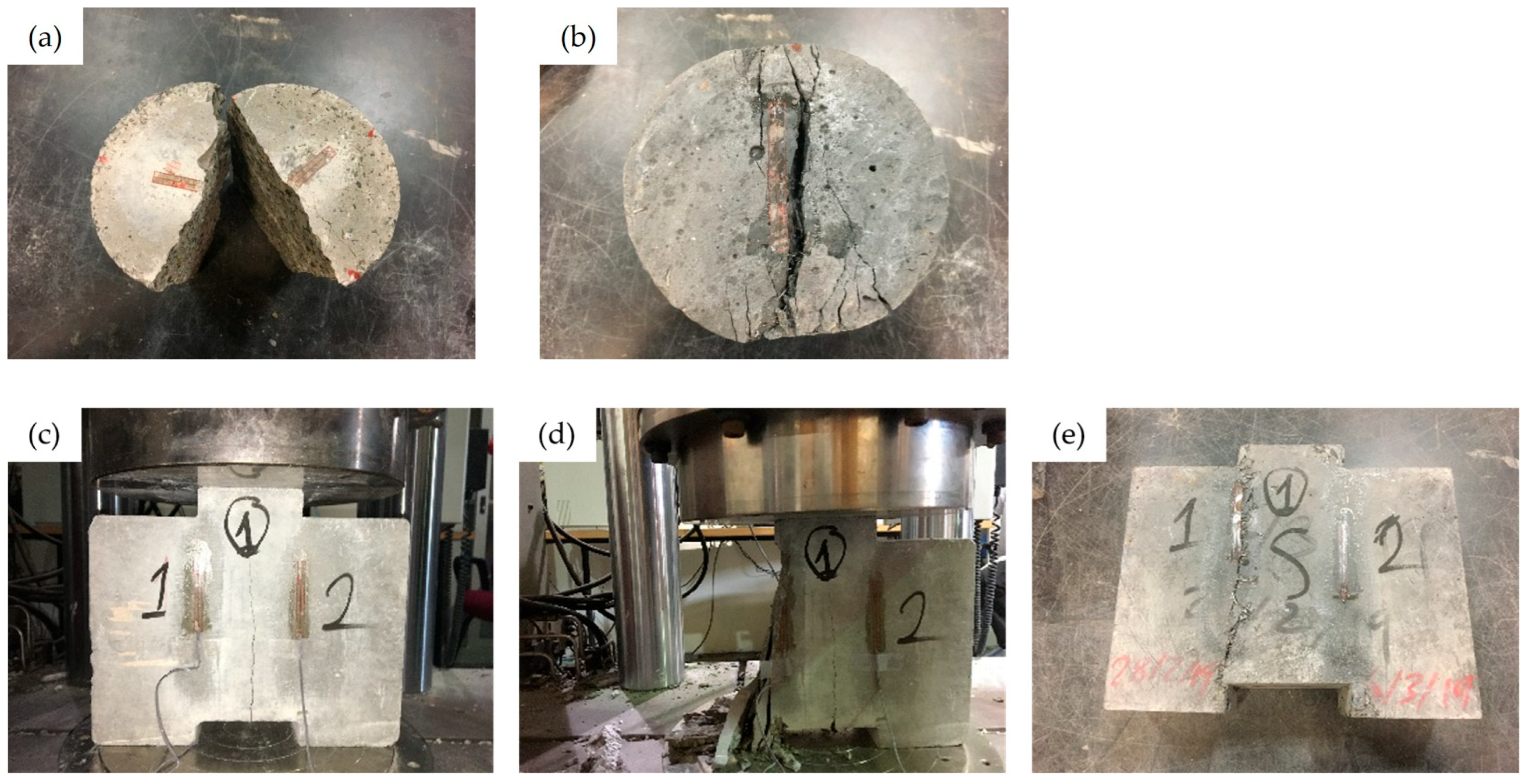
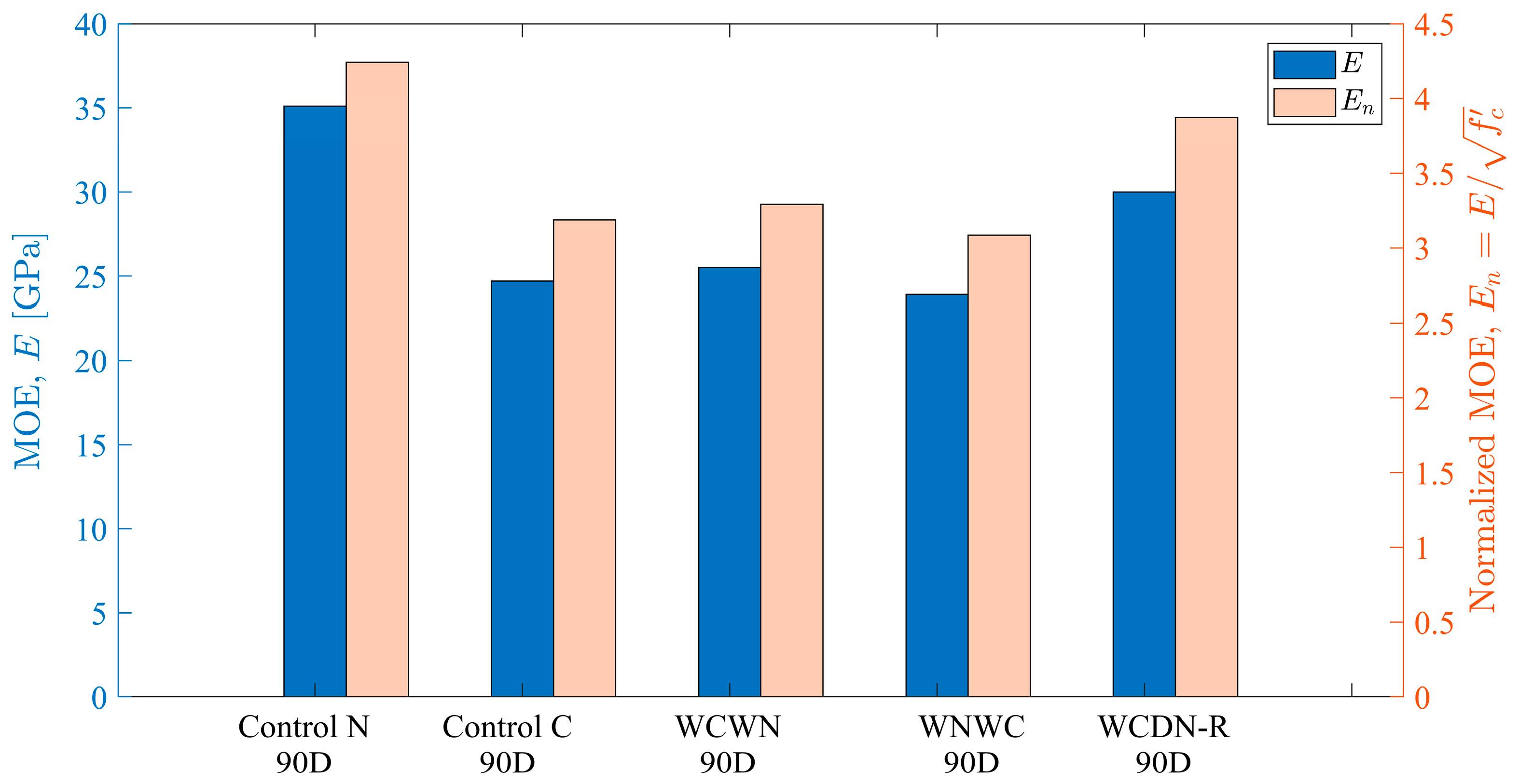

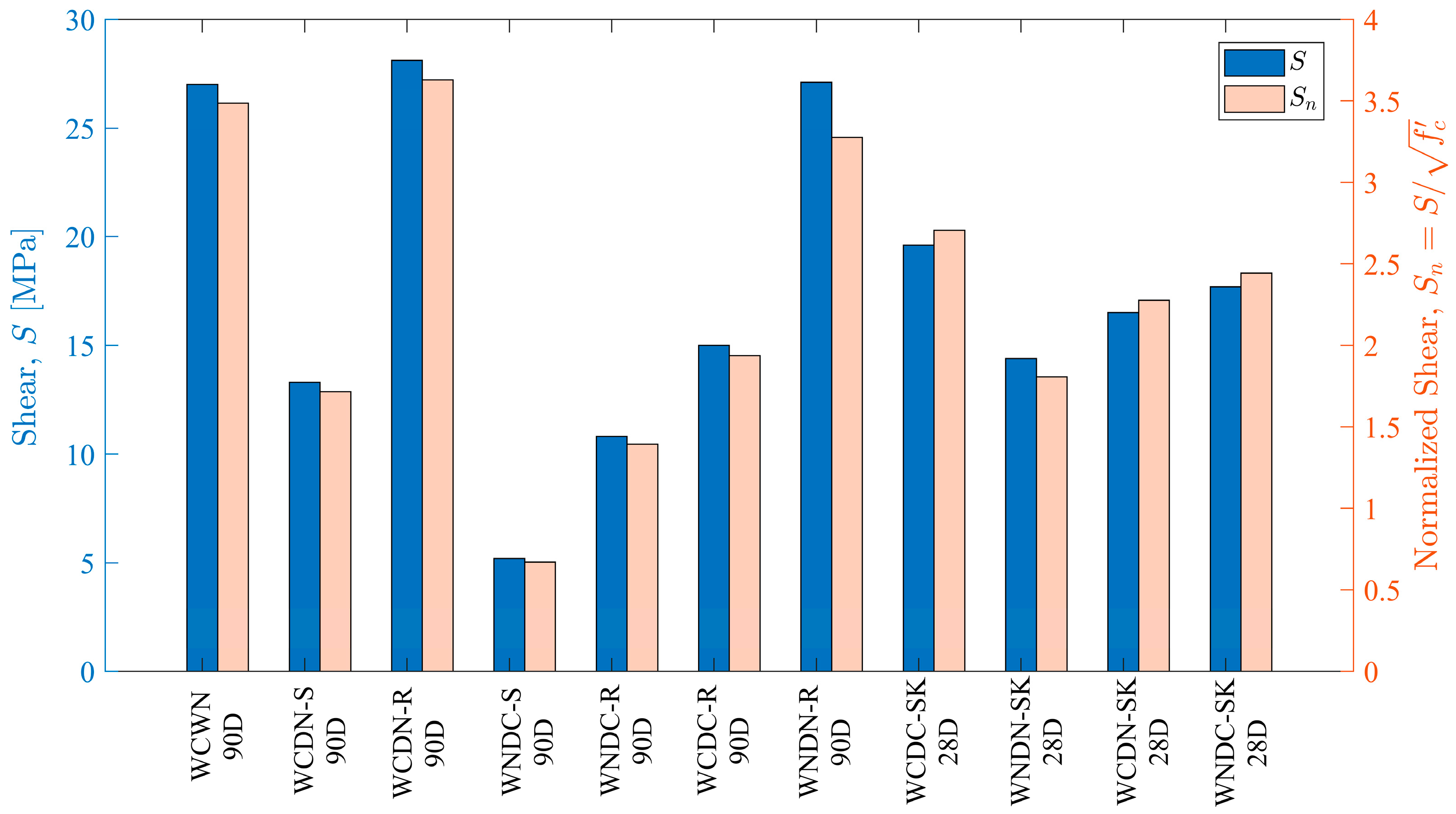





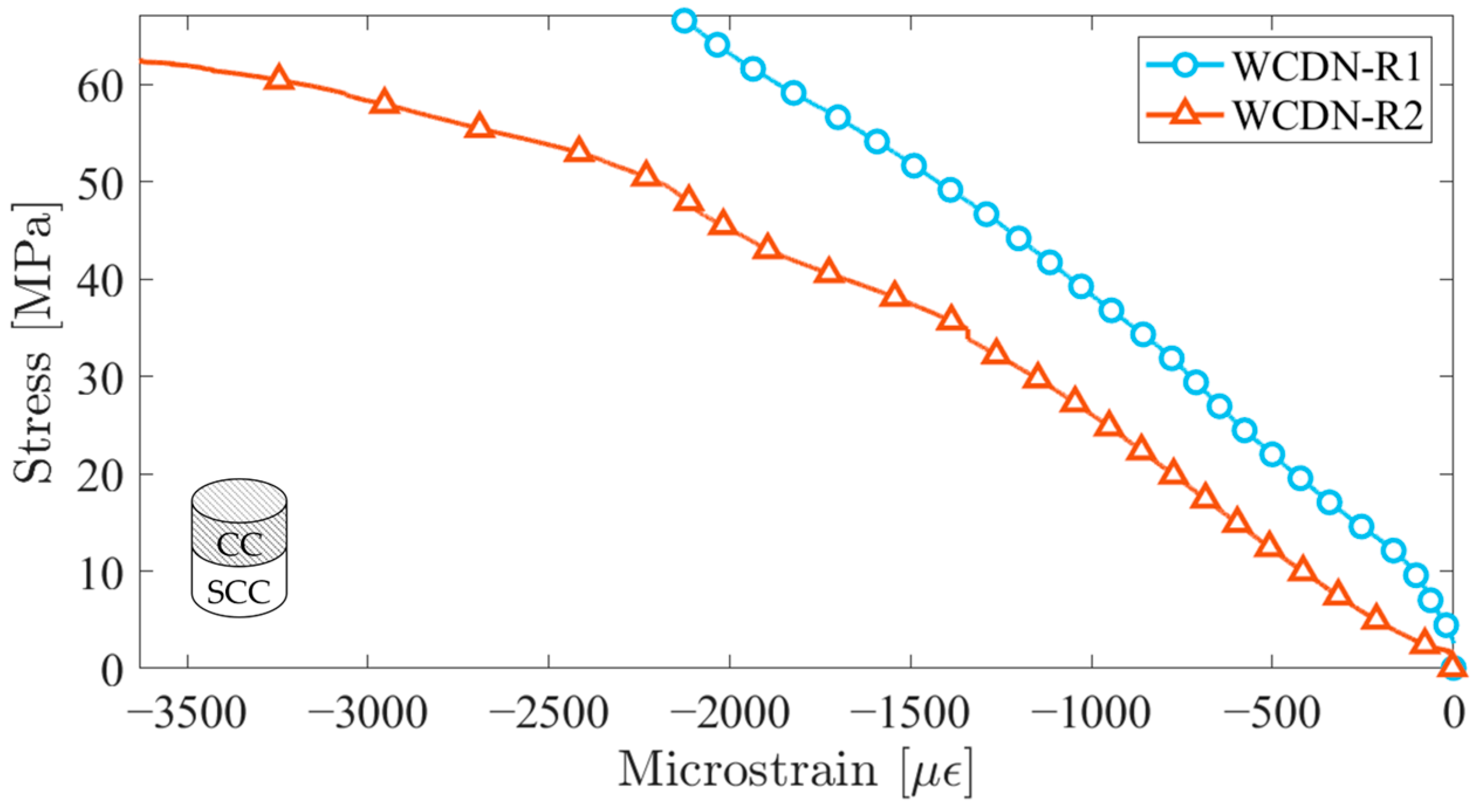
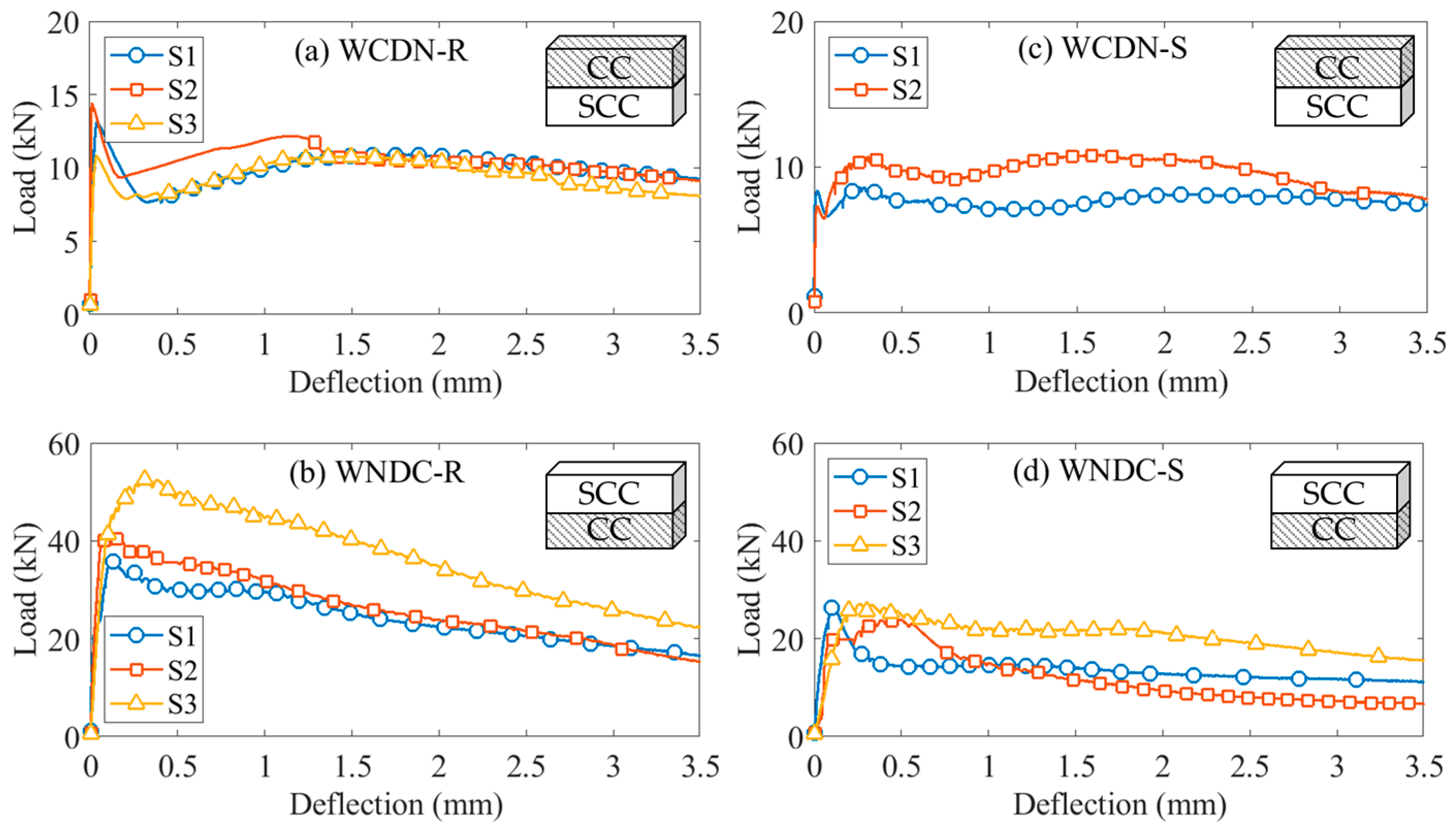
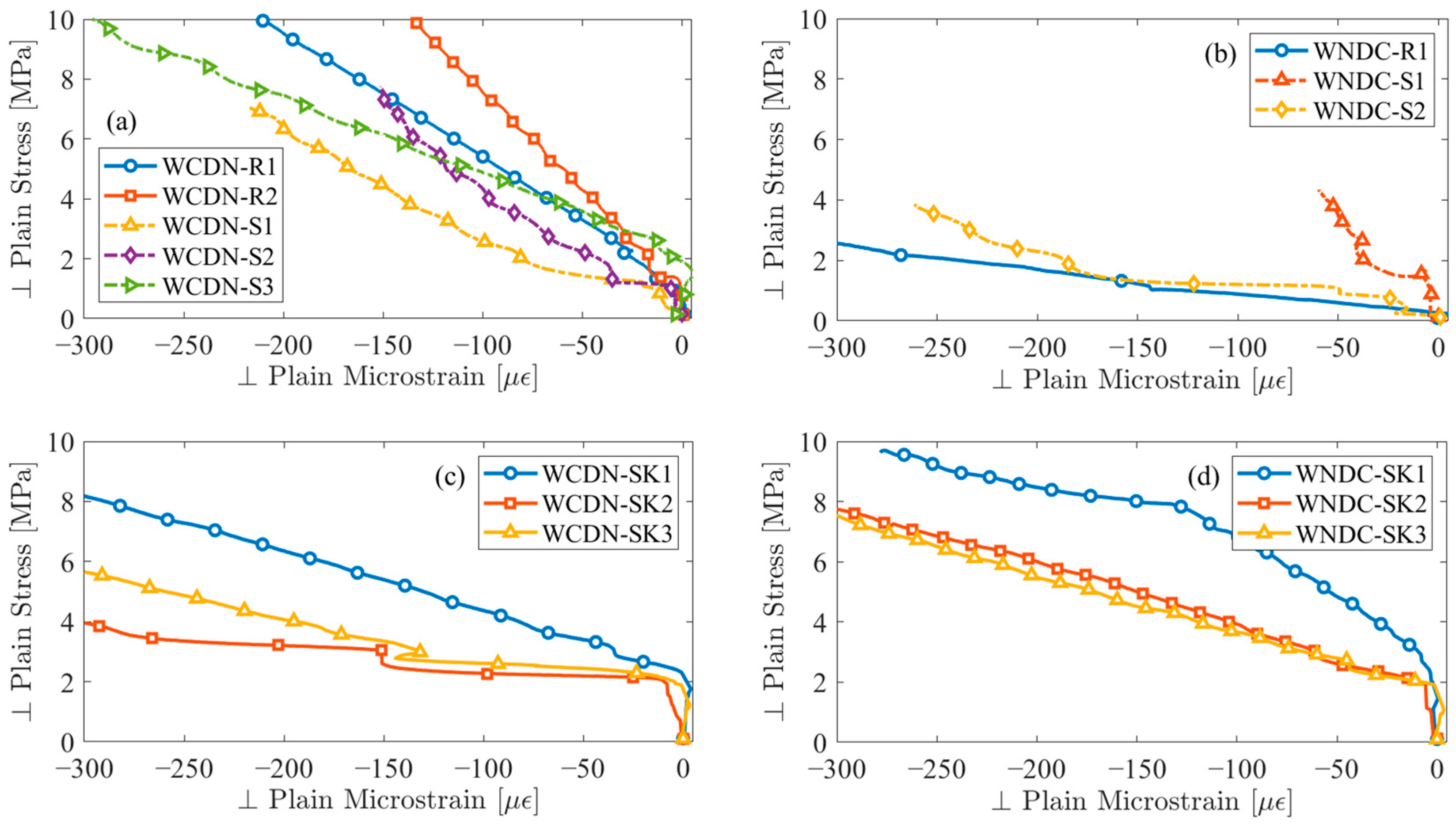


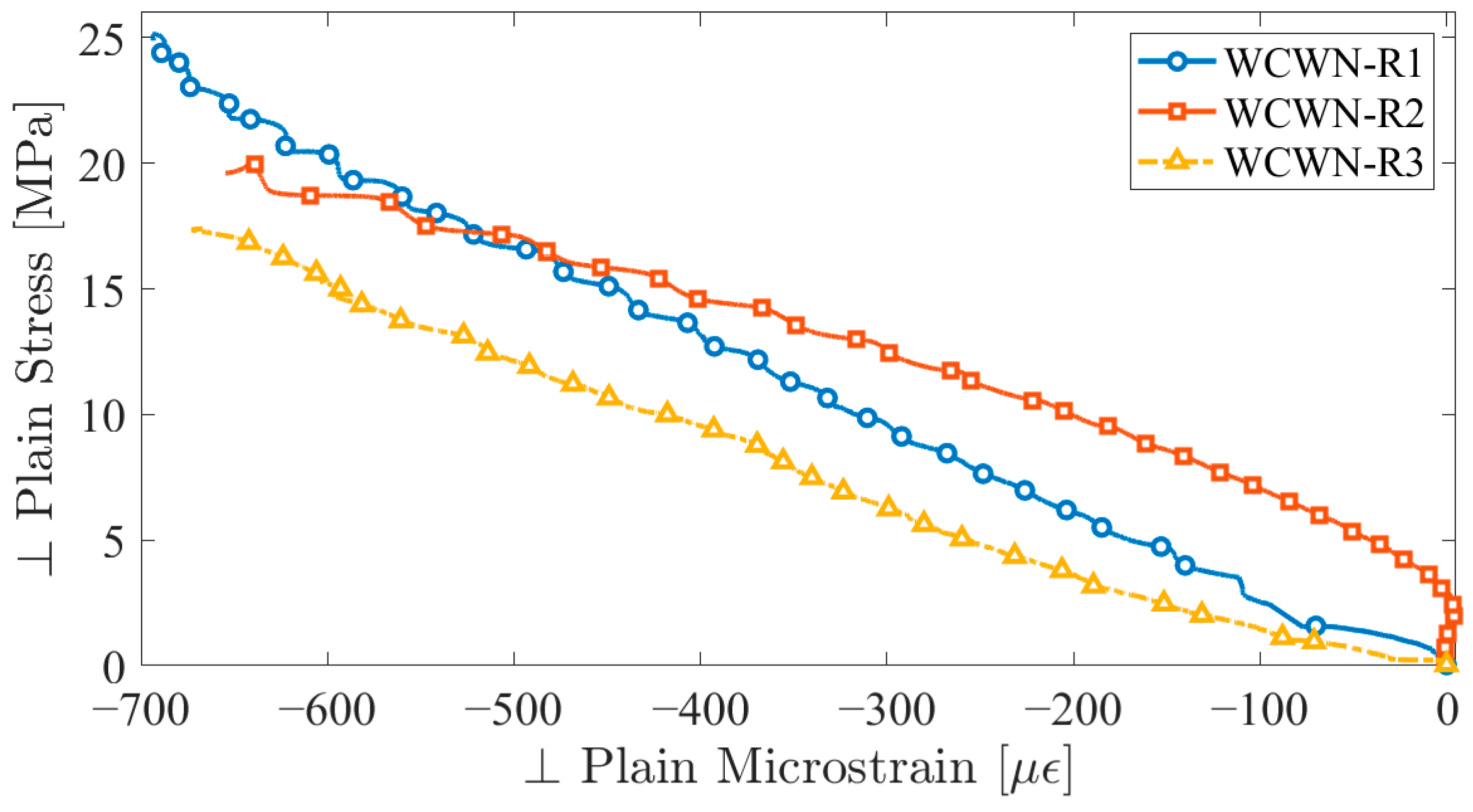


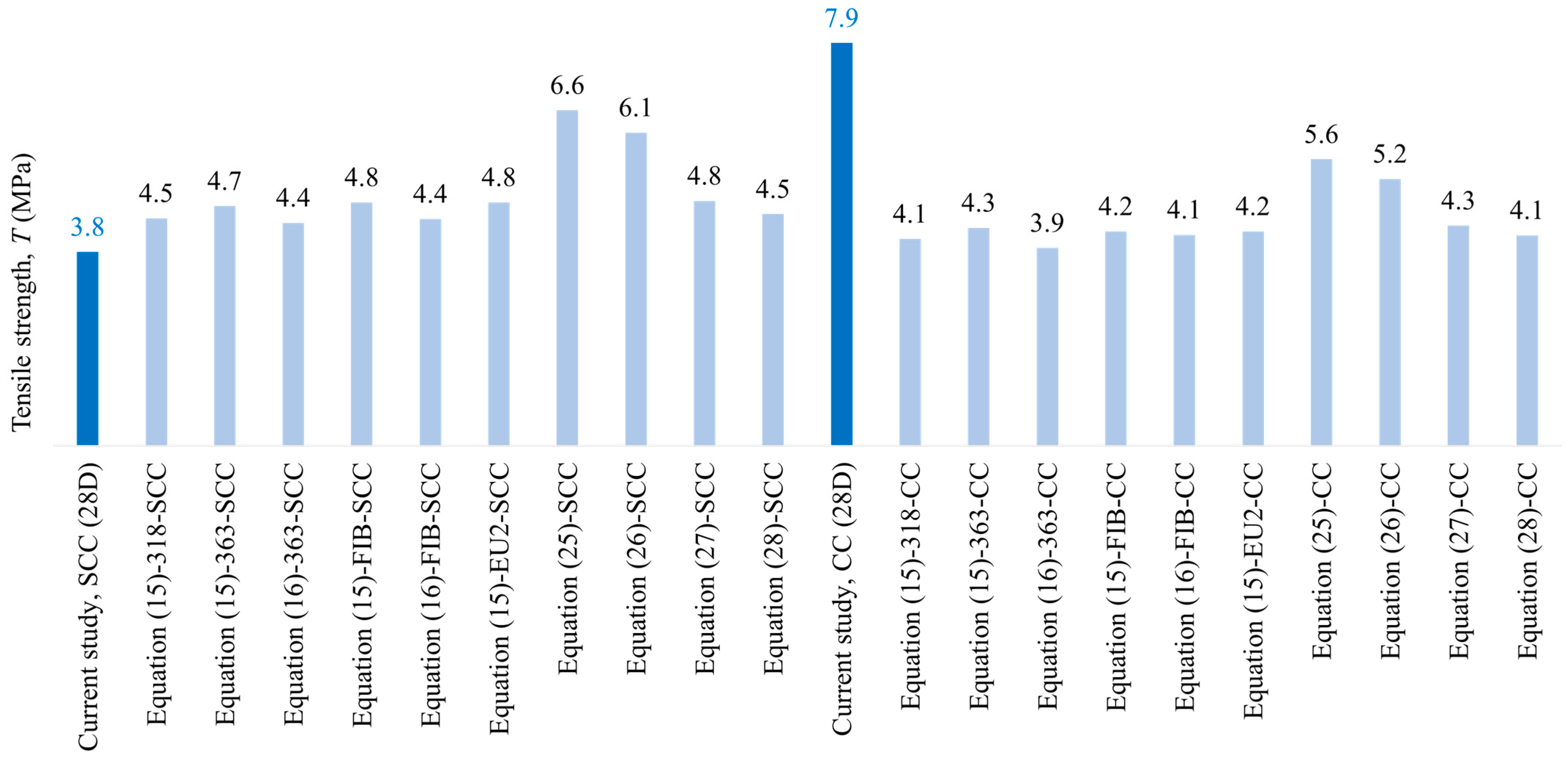
| Test | Sample Size (mm) | Testing Code | Sample Prep. | No. of Samples | (MPa) |
|---|---|---|---|---|---|
| Compression | 100 × 200 (S) 150 × 300 (L) | ASTM C39 [42] | Control N, 28D | 2S & 2L | 63.5 |
| Control C, 28D | 2S & 2L | 52.5 | |||
| Control N, 90D | 1S & 7L | 68.4 | |||
| Control C, 90D | 1S & 9L | 60 | |||
| WCDN-R, 90D | 4L | 66.5 | |||
| WNDC-R, 90D | 3L | 51.3 | |||
| WCDN-S, 90D | 1S | 65.1 | |||
| WNDC-S, 90D | 2L | 63.8 | |||
| WCWN, 90D | 2S & 6L | 66.3 | |||
| WNWC, 90D | 1S & 6L | 65.5 | |||
| Test | Sample Size (mm) | Testing Code | Sample Prep. | No. of Samples | (GPa) (v) |
| MOE | 150 × 300 | ASTM C39 [42] (Loading) ASTM C469 [43] (Calculations) | Control N, 90D | 4L | 35.1 (0.28) |
| Control C, 90D | 6L | 24.7 (0.24) | |||
| WCWN, 90D | 3L | 25.5 (0.24) | |||
| WNWC, 90D | 3L | 23.9 (0.16) | |||
| WCDN-R, 90D | 2L | 30.0 (0.27) | |||
| WNDC-R *, 90D | - | - | |||
| WCDN-S *, 90D | - | - | |||
| WNDC-S *, 90D | - | - | |||
| Test | Sample Size (mm) | Testing Code | Sample Prep. | No. of Samples | (MPa) |
| Flexure | 100 × 100 × 500 | ASTM C1609 [44] | WCWN, 28D | 5 | 4.7 |
| Including steel fiber | WNWC, 28D | 4 | 12.3 | ||
| WCDN-S, 28D | 2 | 2.9 | |||
| WCDN-R, 28D | 3 | 3.8 | |||
| WNDC-S, 28D | 3 | 7.8 | |||
| WNDC-R, 28D | 3 | 13.1 | |||
| ASTM C78 [45] | Control C, 28D | 9 full | 15.0 | ||
| Excluding steel fiber | Control N, 28D | 12 full | 3.8 | ||
| Test | Sample Size (mm) | Testing Code | Sample Prep. | No. of Samples | Bond Shear (MPa) |
| Slant Shear | 100 × 100 × 500 Figure 2a | BS EN 12615:1999 [46] loading rate + inclination angle | WCWN, 90D | 3 | 27.2 |
| WCDN-S, 90D | 3 | 13.3 | |||
| WCDN-R, 90D | 2 | 28.1 | |||
| WNDC-S, 90D | 2 | 5.2 | |||
| WNDC-R, 90D | 2 | 10.8 | |||
| WCDC-R, 90D | 3 full | 15.0 | |||
| WNDN-R, 90D | 3 full | 27.1 | |||
| WCDC-SK, 28D | 3 full | 19.6 | |||
| WNDN-SK, 28D | 3 full | 14.4 | |||
| WCDN-SK, 28D | 3 | 16.5 | |||
| WNDC-SK, 28D | 3 | 17.7 | |||
| Test | Sample Size (mm) | Testing Code | Sample Prep. | No. of Samples | (MPa) |
| Split Tension | 150 × 300 | ASTM C496/C496M-17 [47] | Control N, 28D | 4 | 3.8 |
| Control C, 28D | 4 | 7.9 | |||
| Test | Sample Size (mm) | Testing Code | Sample Prep. | No. of Samples | Shear Strength (MPa) |
| Direct Shear | Figure 2a | Loading based on BS 1881 [48] | Control N, 28D | 3 | 8.4 |
| Control C, 28D | 5 | 19.9 |
| Sample Preparation | Avg. L/600 (MPa) | Avg. L/150 (MPa) |
|---|---|---|
| WCWN, 28D | 3.9 | 3.9 |
| WNWC, 28D | 11.3 | 6.8 |
| WCDN-S, 28D | 2.6 | 2.8 |
| WCDN-R, 28D | 2.7 | 3.2 |
| WNDC-S, 28D | 6.3 | 4.3 |
| WNDC-R, 28D | 11.5 | 8.1 |
| Control C, 28D | 14.4 | 11.0 |
| Control N, 28D | - | - |
| Sample | Failure Criteria * | Avg. Shear Stress (MPa) |
|---|---|---|
| WCDC-SK-1 | b | 19.6 |
| WCDC-SK-2 | a | 19.6 |
| WCDC-SK-3 | a | 19.6 |
| WNDN-SK-1 | c | 14.4 |
| WNDN-SK-2 | c | 14.4 |
| WNDN-SK-3 | a | 14.4 |
| WCDN-SK-1 | b | 16.5 |
| WCDN-SK-2 | a | 16.5 |
| WCDN-SK-3 | b | 16.5 |
| WNDC-SK-1 | a | 17.7 |
| WNDC-SK-2 | a | 17.7 |
| WNDC-SK-3 | c | 17.7 |
| Test | Equation No. | ACI-318 (MPa) | ACI-363 (MPa) | FIB 2010 (MPa) | Eurocode 2 |
|---|---|---|---|---|---|
| MOE | (8) | ; basalt, dense limestone aggr. | |||
| (9) | ; quartzite aggr. | - | |||
| (10) | - | ; limestone aggr. | - | ||
| (11) | - | ; limestone aggr. | - | ||
| (12) | - | - | - | ||
| Flexure | (13) | 0.62 | - | - | |
| (14) | - | ; moist, steam cured | - | - | |
| Split Tension | (15) | ||||
| (16) | - | - |
Disclaimer/Publisher’s Note: The statements, opinions and data contained in all publications are solely those of the individual author(s) and contributor(s) and not of MDPI and/or the editor(s). MDPI and/or the editor(s) disclaim responsibility for any injury to people or property resulting from any ideas, methods, instructions or products referred to in the content. |
© 2023 by the authors. Licensee MDPI, Basel, Switzerland. This article is an open access article distributed under the terms and conditions of the Creative Commons Attribution (CC BY) license (https://creativecommons.org/licenses/by/4.0/).
Share and Cite
EL-Afandi, M.; Yehia, S.; Landolsi, T.; Qaddoumi, N.; Elchalakani, M. Self-Consolidated Concrete-to-Conductive Concrete Interface: Assessment of Bond Strength and Mechanical Properties. Fibers 2023, 11, 106. https://doi.org/10.3390/fib11120106
EL-Afandi M, Yehia S, Landolsi T, Qaddoumi N, Elchalakani M. Self-Consolidated Concrete-to-Conductive Concrete Interface: Assessment of Bond Strength and Mechanical Properties. Fibers. 2023; 11(12):106. https://doi.org/10.3390/fib11120106
Chicago/Turabian StyleEL-Afandi, Mohammed, Sherif Yehia, Taha Landolsi, Nasser Qaddoumi, and Mohamed Elchalakani. 2023. "Self-Consolidated Concrete-to-Conductive Concrete Interface: Assessment of Bond Strength and Mechanical Properties" Fibers 11, no. 12: 106. https://doi.org/10.3390/fib11120106






